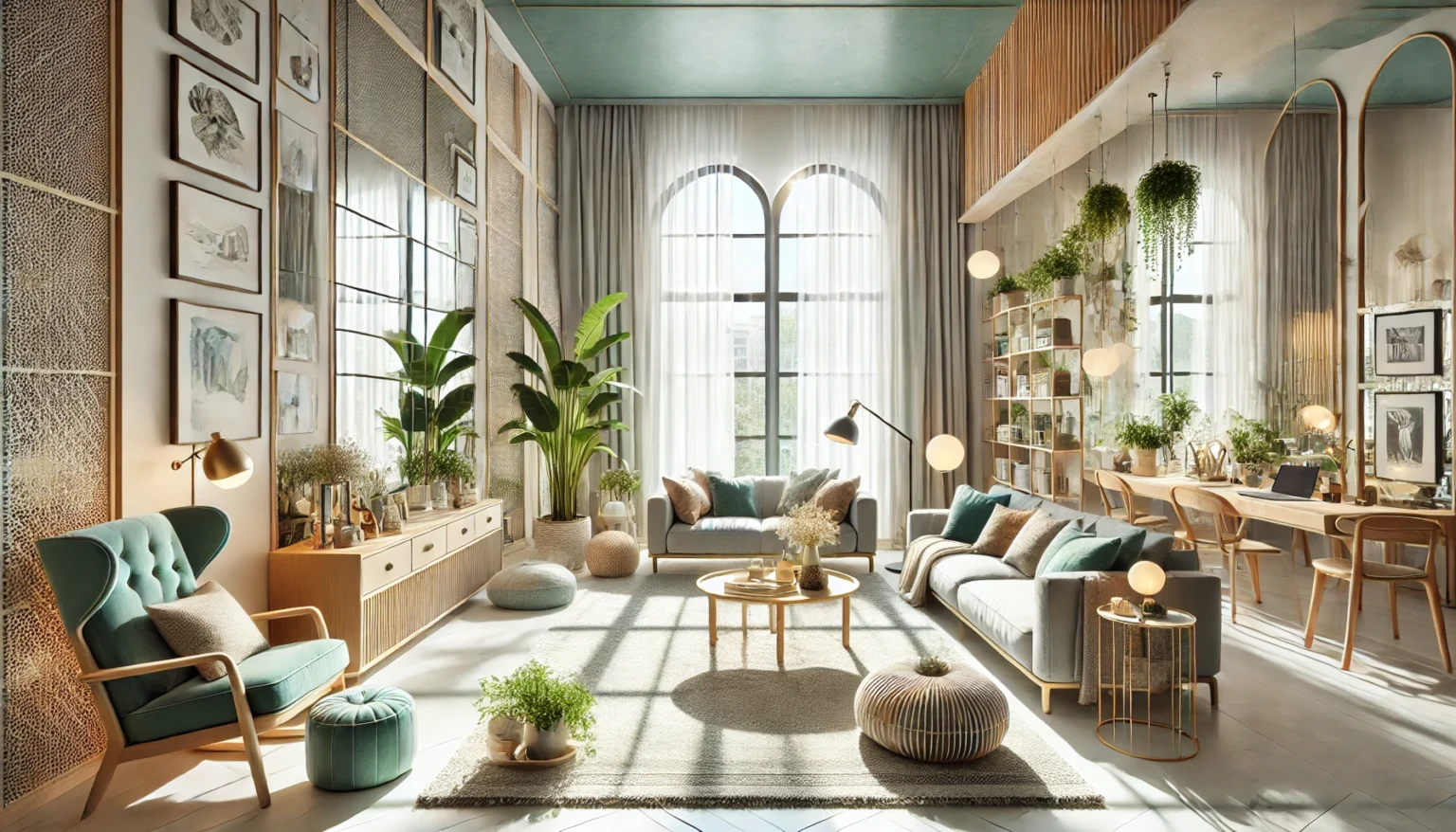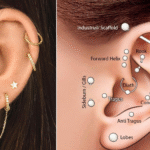1. Introduction
Our living spaces influence more than just how we move through our day—they shape how we feel. Whether it’s the warm hug of natural light, the calming touch of soft textures, or the serene feeling that comes from an organized room, design directly affects our emotions. This guide from MintpalDecor explores how interior design affects mental health, explaining the science and simplicity behind design choices that support wellness. From layout and light to color and clutter, every design element can make a difference in how you think, feel, and heal.
2. The Psychology of Space
Environmental psychology is the study of how our surroundings impact our minds. When we step into a well-designed room, we often feel comforted—even if we can’t explain why. That’s because our brains are constantly processing spatial arrangements, lighting, textures, and visual harmony.
A poorly lit, crowded, or chaotic space can elevate cortisol (stress hormone) levels, while open, organized, and naturally lit environments tend to lower stress and promote relaxation. Interior design isn’t just about aesthetics—it’s a silent partner in mental wellness.
3. Color Psychology: The Emotional Impact of Color
Colors speak to the brain in powerful ways. The right hues can calm anxiety, boost focus, or energize us. But the wrong color combinations can make us feel overwhelmed or even depressed.
Emotional Effects of Common Colors:
| Color | Emotional Impact | Best Rooms For Use |
|---|---|---|
| Blue | Calming, lowers blood pressure | Bedrooms, bathrooms |
| Green | Restful, refreshing, natural | Living rooms, reading nooks |
| Yellow | Energizing, optimistic | Kitchens, creative studios |
| Grey | Neutral, calming or dull depending | Offices, minimalist spaces |
| Red | Stimulating, can cause stress in excess | Dining areas, accent walls |
Color choice plays a central role in how interior design affects mental health. MintpalDecor encourages clients to use colors purposefully—soft earth tones for serenity or brighter hues for motivation, depending on the room’s intent.
4. The Power of Natural Light
Natural light isn’t just visually appealing—it also helps regulate our circadian rhythms (internal body clocks), influences serotonin production, and supports better sleep.
A space flooded with daylight improves alertness, reduces depression, and fosters positivity. On the other hand, rooms with poor lighting may contribute to fatigue, irritability, and even seasonal affective disorder (SAD).
MintpalDecor’s tips for better light design include:
- Using sheer curtains or blinds to let sunlight in
- Installing mirrors to reflect natural light
- Opting for warm-tone LED lighting in low-light zones
These simple strategies show how interior design affects mental health MintpalDecor–by ensuring that homes feel bright, airy, and emotionally uplifting.
5. Biophilic Design: Bringing Nature Indoors
Biophilic design is a fancy term for something very natural—incorporating elements of nature into indoor environments. Humans instinctively connect with nature, and bringing greenery inside can lower blood pressure, reduce anxiety, and increase focus.
Whether it’s a peace lily in the corner, a wooden coffee table, or a water feature with gentle trickling sounds, biophilic design restores balance.
Benefits of Biophilic Elements:
- Reduced stress levels
- Better air quality
- Improved concentration and cognitive function
MintpalDecor helps clients integrate this approach by using eco-friendly materials, green walls, and botanical prints—all evidence of how interior design affects mental health through nature-inspired solutions.
6. Decluttering and Organization
A cluttered space equals a cluttered mind. When your surroundings are messy or overly full, your brain has to work harder to process information. This constant overload can cause mental fatigue, irritability, and a lack of focus.
Interior design that prioritizes organization helps prevent sensory overload. Using minimalistic furniture, multifunctional storage solutions, and clear surfaces fosters a sense of order and calm.
Tip from MintpalDecor: Create “zones” in your rooms—reading zones, work zones, and rest zones—to help your brain switch modes easily.
This zoning method is a great example of how interior design affects mental health MintpalDecor.
7. Furniture Layout and Spatial Planning
The arrangement of furniture impacts how we move, interact, and relax. Poor layouts can lead to discomfort, frustration, and even physical stress. Well-thought-out planning ensures smoother movement and psychological comfort.
Key Considerations:
- Leave clear walkways to avoid feeling boxed in
- Position seating to encourage conversation and natural light exposure
- Use ergonomic furniture to avoid strain
MintpalDecor emphasizes flow in its designs—not just of space but of energy. Open layouts encourage mental clarity, while cozy corners promote emotional warmth.
8. Textures and Materials: Sensory Experiences
Our environment doesn’t just look a certain way—it feels a certain way. Materials and textures send subtle signals to our nervous systems. Soft fabrics can calm, while rough or cold surfaces may feel harsh or clinical.
Examples of Calming Textures:
- Plush rugs
- Woven fabrics
- Warm wood
- Natural stone
Incorporating a variety of these textures helps soothe the senses. It’s another way how interior design affects mental health, and MintpalDecor ensures every material feels as good as it looks.
9. Personalization and Identity in Design
Your home should reflect your story. Spaces that feature personal touches—photos, art, heirlooms—create a sense of identity and emotional security.
When people see themselves represented in their space, they feel grounded and connected. This boosts self-esteem and resilience.
MintpalDecor’s design philosophy supports personal expression through:
- Custom wall art
- Family photo displays
- Personalized workspaces
Even a small detail like your favorite color on a pillow can make a big emotional difference.
10. Designing for Specific Mental Health Needs
Not all design fits everyone—and that’s okay. Some individuals need spaces that cater to specific neurological or psychological needs.
Examples:
- ADHD: Distraction-free work zones, structured layouts
- Anxiety: Calming color schemes, soft lighting, quiet areas
- Depression: Bright light, uplifting décor, sensory engagement
MintpalDecor designs with empathy and inclusivity, recognizing that how interior design affects mental health varies across individuals.
11. The Role of Technology in Interior Design
While technology can sometimes increase stress, thoughtful tech integration enhances well-being. Smart lighting that mimics natural daylight, voice-activated blinds, or sound-masking systems can create a more comfortable living environment.
At MintpalDecor, technology isn’t about gadgets—it’s about making life easier, quieter, and more harmonious.
12. Case Studies and Real-Life Applications
To show how design impacts well-being, here are examples of real transformations:
| Project Type | Challenge | MintpalDecor’s Solution | Mental Health Benefit |
|---|---|---|---|
| Studio Apartment | Cluttered and dark | Added mirrors, decluttered layout, soft lighting | Reduced anxiety |
| Home Office | Distracting, overstimulating colors | Calming green wall, ergonomic desk chair | Improved focus |
| Family Living Room | Disconnected space | Open layout with circular seating | Boosted social interaction |
These real-life examples demonstrate exactly how interior design affects mental health MintpalDecor.
13. Conclusion
Interior design is more than cushions and colors—it’s a pathway to emotional stability, self-expression, and peace of mind. Every design choice—from lighting to layout—affects how we think and feel. At MintpalDecor, we specialize in creating environments that heal, inspire, and uplift.
Now that you understand how interior design affects mental health MintpalDecor, you can start designing not just for beauty, but for better living.
Other Articles
How Much Does a Health Certificate Cost for a Dog? | Full Guide for Pet Owners
How to Use Health o Meter Scale: Full Informative Guide
What is Subrogation in Health Insurance – Complete & Detailed Guide
Haven Health and Wellness: A Comprehensive Guide to Whole-Person Care








